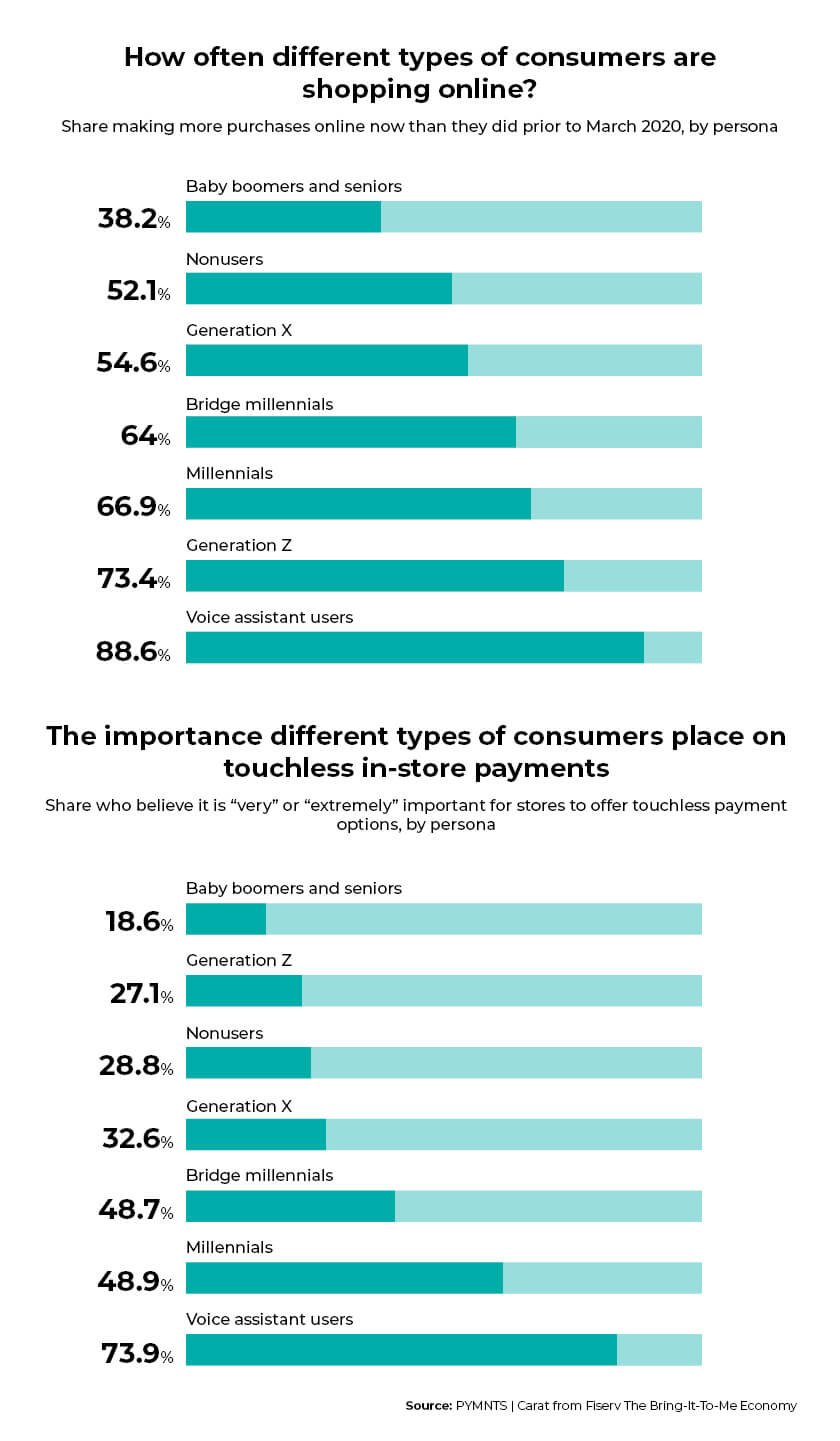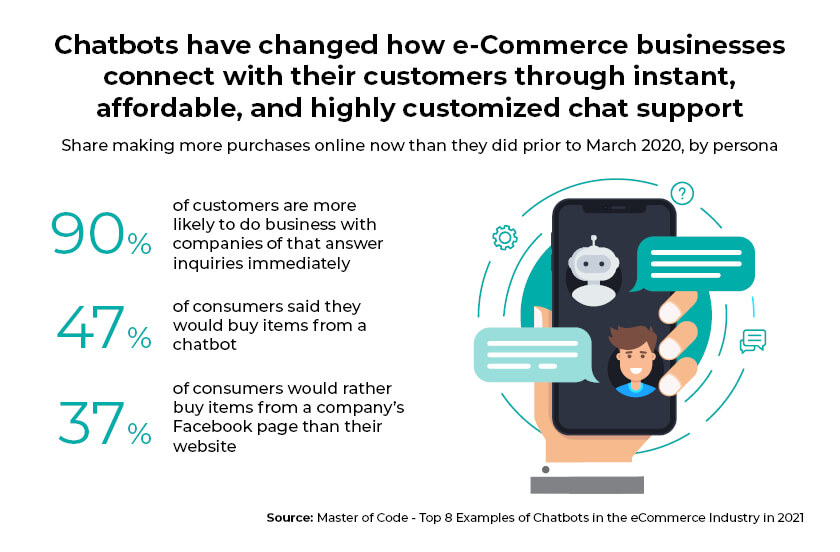The proliferation of voice assistants and other NLP technologies has paved the way for conversational commerce. Voice shopping is estimated to reach USD 40 billion in the US by 2022. While the pandemic is restricting mobility, it has only spurred today’s consumers to increasingly multitask even if that means shopping hands-free.
It’s no surprise why the number of those using voice assistants to complete their routine grocery and household purchases has increased by 42% since 2018. It doesn’t stop there. Conversational commerce is seeing renewed growth even in stores as almost 74% of voice assistant users feel it’s very important to have touchless payment options at the POS to minimize infection exposure. Coming back to the digital world, 86% of online shoppers would like to see proactive customer support, something that businesses can promptly offer through conversational commerce chatbots.
What is conversational commerce?
Conversational commerce essentially is any medium or technology that allows brands and consumers to communicate directly with one another through online voice or chat. It typically involves answering customer queries, facilitating transactions, and providing a personalized experience on your customer’s path to purchase.
Conversational commerce usually uses conversational AI technology, like chatbots and digital voice assistants, to help reduce your customer’s wait time, offering a delightful experience translating to repeat sales and higher customer lifetime value. Some brands also use live representatives to add a personalized touch to their customer communication.
Apps like WhatsApp, WeChat, and Messenger have made conversational commerce ubiquitous. These have led to the increased traction gained by other players like GG, Snapchat, Telegram, and Kik. What makes these platforms and apps so well-received is that it enables brands to be where their customers are, eliminating the necessity to visit their website.

Conversational commerce at work
1. Chatbots
Most shoppers today care less about who answers their queries – a human or a robot. As long as the answer is satisfactory. And brands aren’t stopping there. For instance, H&M uses Kik – a chatbot that acts as a personal digital stylist. It asks the user to answer a series of multiple-choice questions to determine their preferences, before making bespoke recommendations. This could be an entire outfit or the latest trending garb. It also offers the option to see outfits that other bot users have created for inspiration and vote for them.
For customers, this engagement with chatbots not only makes them have an in-store-like experience but also saves them the time of having to wade through all the products online. For the brand, this serves as a priceless opportunity of gaining insights from this customer engagement.

Conversational AI chatbots can answer questions related to deliveries, refunds, and other FAQs, solicit feedback, or enable customized cross-selling and up-selling. A survey showed that nearly 50% of shoppers are open to buying items with the help of a chatbot. Brands like Whole Foods and Sephora are also leveraging chatbots to keep their customers engaged 24×7. Taking this to the next level brands can even allow shoppers to set up chatbot reminders, monitor price, or check the availability of a product.

2. Personalized and contextual push notifications
As consumers, we are all familiar with push notifications from the brands we’ve patronized. These could be in the form of a welcome message, promotional offers, delivery updates, price drop alerts, new product alerts, countdown alerts, review requests, cross-sell pushes, and re-engagement pushes. Yet, this enabler can be a double-edged sword and must be wielded prudently. The strategy that works best is getting customers to opt-in.
Research shows that 43% of smartphone owners are open to receiving in-app promotional messages at least once a week, and an additional 11% once a month. Push notifications in the form of in-app notifications or SMS may seem like a one-way promotion, but when leveraged with dynamic messaging i.e. messaging developed bearing in mind a shopper’s purchase, browsing history, and engagement with you it helps build lasting relationships. A good example would be a retailer, knowing a customer’s birthday, offering a personalized discount on items in their cart.

3. Live chat agents
Chats have become second nature to shoppers today. In fact, 75% of customers are more likely to spend more with a brand if they can message them rather than call them. However, not all shopper questions can be answered by a bot; and this can cause brands to lose a potential sale to a rival. Here’s where live chat agents are a must-have for most brands.

With complex questions that need immediate answers, time is of essence. For instance, when your customer is having trouble making a payment, having a live agent to support them can reduce cart abandonment and ensure conversions. Live agents are vital, especially for complex products like electronics to convert primed leads into customers.
That’s why brands like Samsung, Dell and many more offer live chat options with an expert to help customers make informed purchase decisions and answer highly specific product queries. Live chat processes are more affordable compared to phone call processes and are highly personalized. In fact, 25% of customers reported using live chat more during the pandemic.

4. Digital voice assistants
Searching using your voice is 3.7x quicker than typing. With the usage of digital assistants touching one billion worldwide, technologies like Amazon’s Echo, Alexa, Apple’s Siri, and Google Home are enabling conversational commerce through voice commands.
This is further elevating the level of convenience in online shopping. Voice assistants help customers feel well serviced as these technologies go beyond just executing a command to keeping them entertained and engaged much like a close friend who understands their eccentricities.
Here’s a case in point. Shopping is intuitive, hands-free, and seamless once you have your credit card information integrated with a platform like Alexa. Taking it beyond conversations, Amazon Echo Look currently only available in the US, spells good news for fashion brands and retailers. The product – a depth-sensing camera essentially blurs the background, bringing the shopper’s outfit to the foreground. It also allows users to curate a personal lookbook and share photos with friends to get their opinions.
The benefits of conversational commerce
- Be there for your customers anytime anywhere:
Chatbots, whether on your website or on Facebook Messenger, give retailers the advantage of making their customers feel they are always available when they need them.
- Drive cost-effective CX:
Whether a brand or retailer chooses automated chatbots or a live chat agent process, they are bound to witness a positive impact on their bottom line.
- Close more potential leads:
71% of shoppers would spend more with a brand that provides them an easy messaging option rather than a call.
- Reduce cart abandonment rate:
With timely, informative, and engaging follow-up communication using various conversational commerce formats, you can get customers to take action before they change their minds. They can pay via chat channels. - Gather valuable insights:
Conversational commerce is highly measurable and can provide a stream of valuable customer data to better understand your customer, optimize your marketing campaign, drive deeper personalizations, and inspire loyalty.
Embracing conversational commerce provides brands and retailers with an excellent way to innovate customer experiences and enhance sales across channels. However, not all formats are created equal. Therefore based on your customers’ preferences, and your product type, as a business you need to adapt your own strategy and channel selection accurately to your target group.
Netscribes provides some of the world’s leading e-commerce companies and brands, not just the right insight to steer their conversational commerce investments but the most efficient solutions as well. To know how we can help your business take on the reins of conversational commerce contact us.








